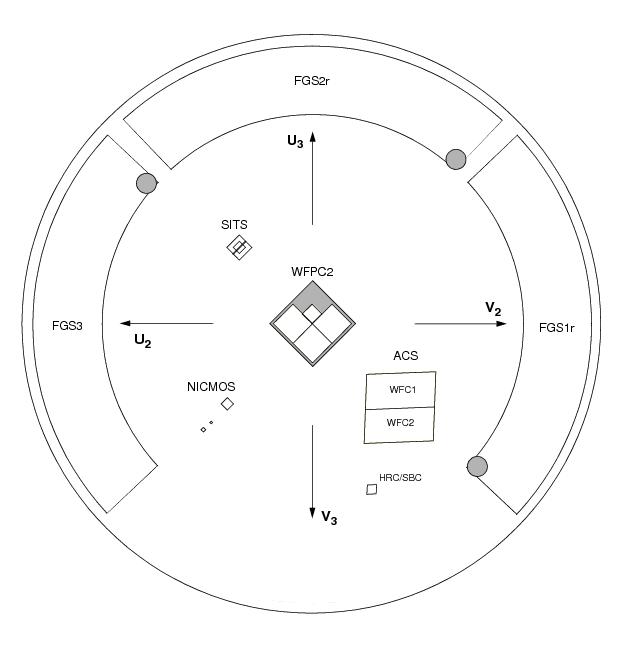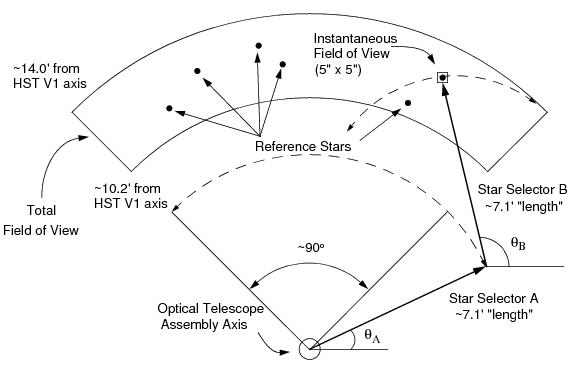1.2 Technical Overview
1.2.1 The Instrument
The FGS is a white-light shearing interferometer. It differs from thelong-baseline Michelson Stellar Interferometer in that the angle of the incoming beam with respect to the HST’s optical axis is measured from the tilt of the collimated wavefront presented to the “Koesters prism” rather than from the difference in the path length of two individual beams gathered by separate apertures. Thus, the FGS is a single aperture (singletelescope) interferometer, well suited for operations aboard HST. The FGS is a two dimensional interferometer; it scans or tracks an object’s fringes in two orthogonal directions simultaneously. As a science instrument, the FGS can observe targets as bright as V = 3 and as faint as V = 16.8 (dark counts dominate for targets of V > 17).
Spectral Response
The FGS employs photomultiplier tubes (PMTs) for detectors. ThePMTs—four per FGS—are an end-illuminated 13-stage venetian blind dynode design with an S-20 photocathode. The PMT sensitivity is effectively monotonic over a bandpass from 4000 to 7000A, with an ~18% efficiency at the blue end which diminishes to ~2% at the red end.
Each FGS contains a filter wheel fitted with 5 slots. FGS1r containsthree wide-band filters, F550W, F583W (sometimes called CLEAR), F605W, a 5-magnitude Neutral Density attenuator (F5ND), and a 2/3 pupil stop, referred to as the PUPIL. Not all filters are supported by standard calibrations. Transmission curves of the filters and recommendations for observing modes are given in Chapters 2 and 4 respectively.
The S-Curve: The FGS’s Interferogram
The FGS interferometer consists of a polarizing orthogonal beamsplitter and two Koesters prisms. The Koesters prism, discussed in Chapter 2 of the FGS Instrument Handbook, is sensitive to the tilt of the incoming wavefront. Two beams emerge from each prism with relative intensities correlated to the tilt of the input wavefront. The relation between the input beam tilt and the normalized difference of the intensities of the emergent beams, measured by pairs of photomultiplier tubes, defines the fringe visibility function, referred to as the “S-Curve”. Figure 1.1 shows the fringe from a point source. To sense the tilt in two dimensions, each FGS contains two Koesters prisms oriented orthogonally with respect to one another. See the FGS Instrument Handbook for more details.
FGS1r and the AMA
During the Second Servicing Mission in March 1997 the original FGS1 was replaced by FGS1r. This new instrument was improved over the original design by the re-mounting of a flat mirror onto a mechanism capable of tip/tilt articulation. This mechanism, referred to as the Articulated Mirror Assembly, or AMA, allows for precise in-flight alignment of the interferometer with respect to HST’s Optical Telescope Assembly (OTA). This assured optimal performance from FGS1R since the degrading effects of HST’s spherically aberrated primary mirror would be minimized (COSTAR did not correct the aberration for the FGSs).
Field of View
The total field of view (FOV) of an FGS is a quarter annulus at the outer perimeter of the HST focal plane with inner and outer radii of 10 and 14 arcmin respectively. The total area (on the sky) subtended by the FOV is ~ 69 square arcmintues.The entire FOV is accessible to the interferometer, but only a 5 × 5 arcsec aperture, called the Instantaneous Field of View (IFOV), samples the sky at any one time. A dual component Star Selector Servo system (called SSA and SSB) in each FGS moves the IFOV to a desired position in the FOV. The action of the Star Selectors is described in detail in Chapter 2, along with a more detailed technical description of the instrument. Figure 1.2 shows a schematic representation of the FGSs relative to the HST focal plane.
1.2.2 Modes of Operation
The FGS has two modes of operation: Position Mode and TransferMode.
Position Mode
The FGS Position Mode is used for relative astrometry, i.e. parallax,proper motion, reflex motion and position studies. In Position Mode, the HST pointing is held fixed while selected FGS targets are sequentially observed for a period of time (2 < t < 120 sec) to measure their relative positions in the FOV. Two-dimensional positional and photometric data are continuously recorded every 25 msec (40 Hz). The raw data are composed of a Star Selector encoder angles (which are converted to FGS X and Y detector coordinates during ground processing) and photomultiplier (PMT) counts, is a schematic of the FGS FOV and IFOV. The figure shows how Star Selectors A and B uniquely position the IFOV anywhere in the FGS FOV.
Transfer Mode
In Transfer Mode, the FGS obtains an object’s interferograms in two orthogonal directions by scanning the Instantaneous Field of View (IFOV) across the target (typically in 1" scan lengths). Transfer Mode observing is conceptually equivalent to imaging an object with sub-milliarcsecond pixels. This allows the FGS to detect and resolve structure on scales smaller than HST’s diffraction limit, making it ideal for detecting binary systems with separations as small as 8 mas with ~ 1 mas precision.
1.2.3 FGS Capabilities
Each Fine Guidance Sensor on HST is an optical-mechanical white-light interferometer that can sense 1–2 milliarcsecond (mas) angular displacements of a point source in two dimensions over the range of apparent visual magnitudes from 3 <V< 15. It can observe fainter objects down to V< 17, but its accuracy degrades to more than 2 mas. The instrument’s spectral response is fairly flat from 4000 Å to 7200 Å, with sharp drop-offs outside this range.
The optical path through an FGS is complex because the beam passes through multiple optical elements. The relative alignment of all these components and the wavelength dependencies introduced by their reflective surfaces and refractive optics impose the resolution and magnitude limits of the FGS. Most of the FGS calibration procedure consists of empirical and semi-empirical subtraction of the instrument’s signature, necessitating observations of standard stars in various spectral ranges and all modes of observation.
The three FGSs on board HST occupy three of the four radial bays.Normally two FGSs are used for pitch, yaw, and roll control of the telescope, leaving one available for astrometry. The telemetry from the guiding FGSs is captured and processed by the ground system and stored in the Hubble Data Archive. Processed FGS telemetry can be retrieved for any HST observation with any Science Instrument (SI) in the form of observation log files, which provide information on spacecraft jitter.
Position Mode observing is used both to guide the telescope and for positional astrometry. Transfer Mode is used primarily to support astrometry science programs investigating multiple star systems or extended objects, but is on occasion used in engineering tests to evaluate the FGS and the OTA optical systems.
FGS 1R is the only FGS currently designated and calibrated as anastrometer. This FGS can measure point-source angular positions of 1–2 mas over the brightness range of 3 to 17 magnitudes and can resolve the components of binary systems with separations as small as 10 mas. For many scientific studies, this FGS continues to exceed ground based efforts in sensitivity, dynamic range, and resolution.
1.2.4 FGS Control
Two different kinds of computers can control the three FGSs. One is HST’s housekeeping computer, the 486. The other is the Fine Guidance Electronics (FGE) microprocessor associated with each FGS. Both the FGEs and the 486 control the FGSs while they are guiding HST. However, when one of the FGSs is being used as an astrometer in Position Mode, it is under the control of its associated FGE. When scanning in Transfer Mode, the FGS is under control of the 486.
The fundamental time interval for an FGS is 25 milliseconds, the shortest time over which the FGSs can compute a fine error signal or respond to commands. Independent of instrument mode or activity, the 486 gathers all FGS data at 25 millisecond intervals, assigns them specific locations in the engineering telemetry stream, and downlinks them to the ground. The engineering telemetry format at the time of transmission determines what FGS data are included in the downlink and the rates at which they are reported.


